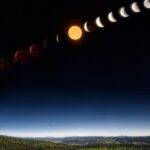Rare Celestial Event to Enthrall Stargazers
Stargazers worldwide are eagerly anticipating another extraordinary cosmic event following the recent total solar eclipse. Astronomers have revealed that the binary system T Coronae Borealis (T CrB), situated approximately 3,000 light years away, is poised for an exceptionally rare nova explosion later in 2024, as reported by Space.
Anticipating the Spectacle
NASA has indicated that the event could occur anytime between now and September, with astronomers poised to unveil a more precise timing once calculations are finalized. Nova explosions, like the one anticipated with T CrB, are exceedingly infrequent, occurring roughly once a century, making this a once-in-a-lifetime occurrence for many.
Unveiling the Mechanism Behind the Phenomenon
Scientists elucidate that such events transpire when a collapsed white dwarf star and a red giant star draw too close to each other. This proximity causes a drastic surge in the temperature of the red giant’s surface, soaring from typical temperatures of 4,000 to 5,800 degrees Fahrenheit to a staggering 360,000 degrees Fahrenheit, as per Earth.
A Phenomenal Release of Energy
The heightened temperature prompts the red giant to expel its outer layers onto the white dwarf, triggering a colossal explosion akin to a nuclear detonation. This explosion unleashes an energy burst approximately 100,000 times greater than the Sun’s annual output, leaving observers in awe of its magnitude.
The Cycle of Renewal
Following the explosion, the star enters a cooling phase, gradually returning to its pre-explosion state before the cycle recommences. Notably, unlike a supernova, this event does not obliterate the star. T CrB and its two constituent stars have experienced eruptions over the years, with notable occurrences documented in 1946 and 1866, and potentially spanning centuries.
The Unique Duration and Visibility
An exceptional aspect of this event is its rapid completion within a week. The event’s peak brightness will render it visible to the naked eye on Earth for several days, extending over a week when observed through binoculars or a telescope. Given the last recorded explosion in 1946, astronomers speculate a recurrence every 79 years, hinting at a possible event in 2103.
Optimal Viewing Recommendations
To witness this celestial spectacle, enthusiasts are advised to look towards the Corona Borealis constellation, also known as the Northern Crown, situated near Bootes and Hercules, as per NASA’s guidance.
Conclusion: Experience the Celestial Marvel
As anticipation builds for the rare nova explosion of T Coronae Borealis, astronomers and stargazers alike eagerly await the awe-inspiring display set to illuminate the skies, offering a once-in-a-lifetime glimpse into the cosmic wonders of our universe.







Leave a Reply